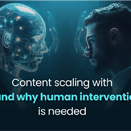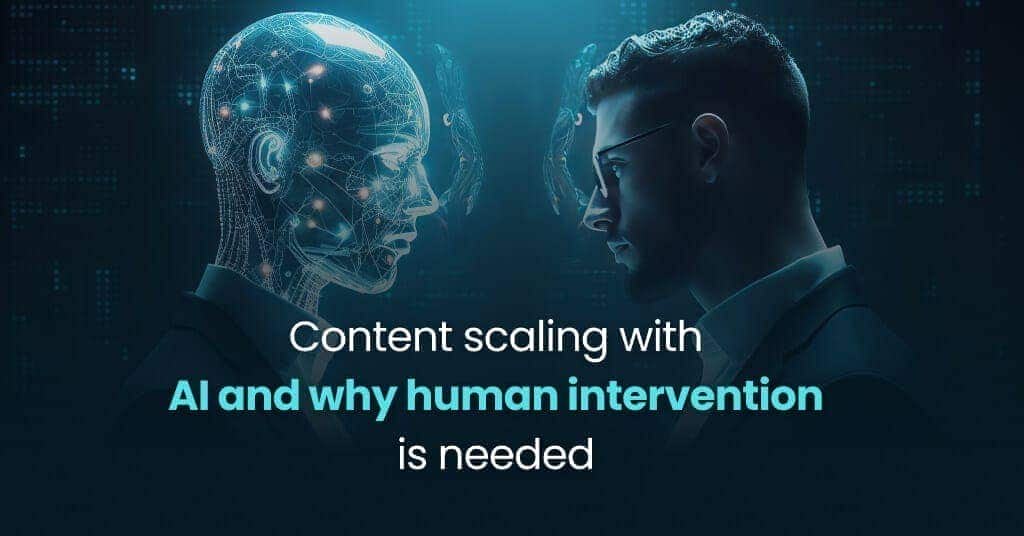
There has been a constant buzz around AI and ChatGPT, the most widely known AI-based content generation tool, for quite some time now. Perhaps you’ve already tried it, or maybe you’re considering taking the plunge. With more than 100 Million active users of ChatGPT alone, there has been an explosion of AI-based content generation tools in the market, including Copy.ai, Writesonic, Copymatic, etc.
With proper prompts and refinement requests, you can ask these tools to write a newsletter, article, interesting poem, song, and whatnot. While some people are heavily using these tools for quick content generation, there are others who believe that AI spell is nothing but an end to creativity.
However, it is important to recognize that while these tools have made it easier to scale content creation, they are not a complete replacement for human content creators. Human intervention is still required to ensure the accuracy, relevance, and creativity of the content.
Let’s explore how.
Role of scaling content creation with AI
Businesses in almost every niche are constantly looking for ways to create and distribute high-quality content at scale. However, producing large volumes of content can be a time-consuming and resource-intensive process. This becomes even more difficult for small businesses with a limited team. This is where AI comes in.
By automating certain aspects of the content creation process, businesses can save time and increase efficiency while producing high-quality content. By automating repetitive and time-consuming tasks, AI enables businesses to produce more content in less time.
While some businesses choose to blindly follow the trend, savvy businesses are wondering-
- How good is the quality of AI-generated content?
- How well will AI content perform on Google and other search engines?
- How can we avoid plagiarism and duplication when AI is producing the same content as output?
- What about the loss of human expression and emotion?
If you share these concerns too, we’ll help you clear these doubts. But let’s first know about the top AI tools and their capabilities.
Top AI-powered tools for content creation
Copy.ai
Available in over 25 different languages, Copy.ai is an AI-powered content-writing tool that uses NLP and deep learning to write great copy. With little human input, this tool can generate compelling copy, outlines, and articles. This tool can enable marketers & teams, and businesses to write digital ad copy, eCommerce copy, social media content, website copy, etc.
Writesonic
Unlike ChatGPT (which has its knowledge up to Sep 2021), Writesonic has access to the latest knowledge. This AI writing assistant tool can help you write articles, landing pages, ad copy, product descriptions, etc. The tool offers a free plan with 10 content generation per month.
ChatGPT
Developed by OpenAI, ChatGPT is an intelligent AI chatbot that uses NLP to generate human-like text quickly. It is an excellent choice for businesses, marketers, and content creators looking for a reliable and efficient way to generate high-quality content, such as blog articles, social media posts, emails, product descriptions, and more.
Rytr
Rytr is another AI-powered writing tool that helps you choose from 30+ use cases and enables you to produce high-quality content in your preferred language and tone. From product descriptions to emails, blogs, ad copies, landing page copies, and other forms of content, the tools can assist you with all.
HyperWrite
This is another AI tool that helps users create content faster and in an easier way. By providing the tool with the right set of instructions, it can generate relevant responses. Moreover, this tool can help you customize content to your style. You can simply paste a sample content & the tool will use this as an example to follow your intended style.
AI capabilities in content creation
AI-based content creation tools have revolutionized the way we produce content. These tools are designed to generate a wide range of content types, making it easier and faster to create content. Let’s take a closer look at what type of content can be generated easily with AI tools (We used ChatGPT to show you real examples).
Content outlines
Generating content outlines is a crucial part of content creation. AI tools can assist with this by analyzing the topic and generating a comprehensive outline that is easy to follow. You can also provide instructions to modify the outline or remove or add a section as you deem fit. Moreover, these tools can also aid your research & provide useful content for a given topic.
Have a look at ChatGPT’s response to our prompt- “Create an article outline for the topic Why should businesses turn to outsourcing?”
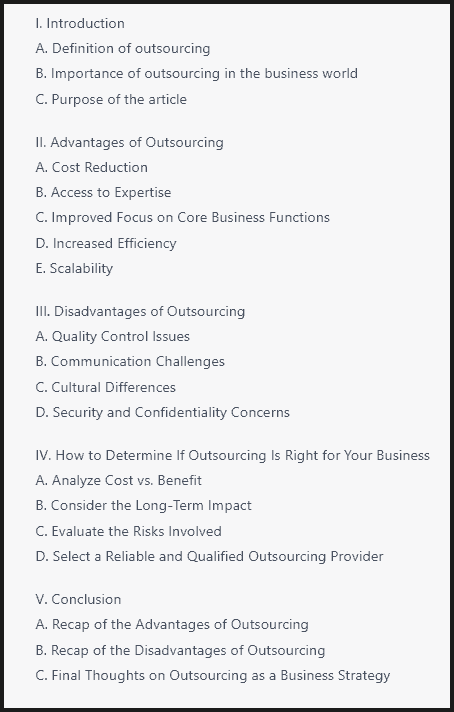
Content Summary
Summarizing long-form content can be a time-consuming task as it requires a person to go through the content, extract key points & prepare an effective summary. However, several AI tools have made this task easy by quickly accessing large-volume content and providing a relevant summary that is concise and to the point in just a few minutes.
We asked ChatGPT to create a short summary of a web page in 150 words, and here’s what we got:
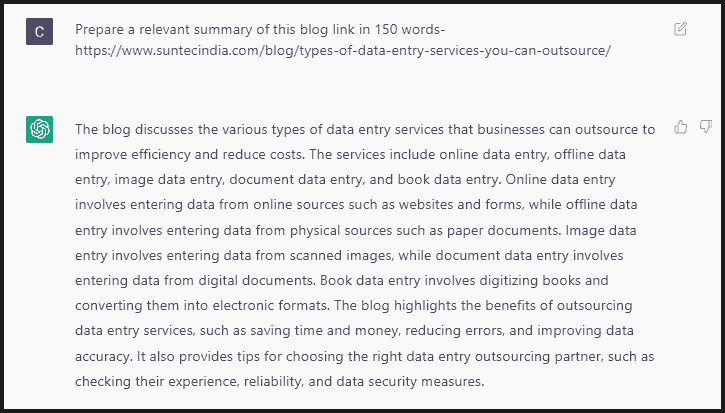
Product descriptions
AI tools have substantially helped eCommerce store owners & merchants write compelling product descriptions that earlier used to be a time-consuming and resource-intensive task, especially when someone had a large inventory. Here’s an example:

However, human-power product descriptions still work to produce descriptions that are more unique, SEO-optimized, creative, and aligned with the brand’s voice.
Generating content ideas
To kill writer’s block, find creative topics, and provide a wide range of perspectives on a given service, subject, or keyword, AI tools can help to identify topic ideas and trending topics that appeal to your buyer persona.
While struggling to find some quirky topic ideas around real photo editing, we got some ideas using ChatGPT. Have a look:

Note: When it comes to writing personal experiences, thoughts, and opinions, human-generated titles and topics cannot be replaced.
Email drafting
Drafting a perfect email can take up a considerable amount of time. This is more challenging if you have to create or respond to multiple emails. AI tools have come a long way in helping users craft compelling and relevant emails. Marketers are also using AI tools to generate persuasive marketing copies that are personalized and engaging.
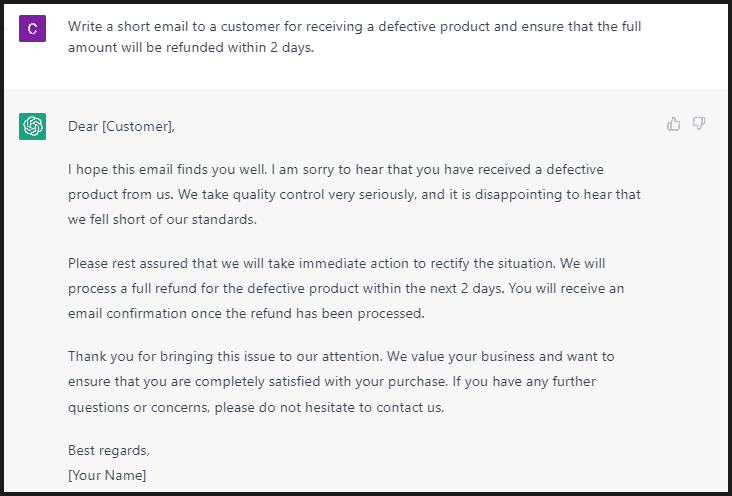
Social media posts
In the quest to keep your social media accounts active and engaging, frequently posting on social media accounts is a must. At the same time, creating multiple posts on a daily basis can be a time-consuming task. AI content generation tools can speed up this process and generate posts in minutes. However, when it comes to understanding the subjective/contextual nuances of your brand and audience, the need for human intervention cannot be ignored to ensure that your posts are relevant.

Images
AI-based content creation tools can also help with personalized image creation. These are great for marketing and advertising teams, where personalized visuals can significantly enhance engagement and conversion rates. AI-powered image creation tools save time and effort by automating image creation tasks and provide you with necessary visuals in minutes.
For instance, on giving a command to Bing Image Creator to design an image of a web developer working on a project, here’s what we got:

The Importance of Human Intervention in AI-Driven Content Creation
All businesses need to create a large volume of content to build their content strategy. However, if your question is- Will AI content generation tools totally replace humans? Well, the clear answer is NO. While AI tools have clearly helped us scale content generation, this has freed up human content creators to focus on more creative and strategic aspects of content creation, such as storytelling, brand messaging, audience engagement, etc.
Limitations of AI in content generation & need for human intervention
Some limitations of AI-based content generation include
Creativity and originality
While AI can help in generating content at scale; however, it lacks the ability to innovate and present creativity and originality like humans. As AI algorithms function on pre-set rules and patterns, they can come up with a human language and behavior to some extent, but they cannot completely innovate or come up with new ideas on their own, leading to limitations in the uniqueness & originality of the content they produce.
Additionally, the content generated with AI tools lacks diverse perspectives and is incapable of sharing opinions. This is where human intervention is needed. Having unique experiences, perspectives, and emotions allows humans to create content that is truly unique, innovative, and original.
Emotional intelligence
When it comes to content creation with emotional intelligence (the ability to understand feelings & emotions), humans have the upper hand. AI tools still lack in crafting stories and messages that reflect true emotions. Human content creators can present emotions in their writing that engage readers and enables them to connect and feel.

Editing & refinement
Directly using content generated by AI tools without proofreading or editing isn’t a good idea. AI-generated content may sometimes lack an understanding of the context, intended tone, or content structure. You may also find numerous redundant sentences & phrases in the content. This can lead to content output that is cluttered, inaccurate, poorly structured, or offensive. Hence, there is a need for editors to edit and proofread content to fix these issues and ensure that it is thoroughly checked for quality.
Up-to-date content
Few AI tools like ChatGPT have vast datasets. However, its knowledge is based on data only up to 2021. In the ever-changing world, producing fresh, highly relevant, and up-to-date content is a must for businesses and hence would imply that such tools can fail here. Moreover, you might not find any information on trending topics and events happing in real-time.

Unique perspective and voice
AI tools lack a unique perspective and voice as they are designed and programmed to generate responses based on patterns and probabilities in large datasets. Since they are incapable of personal thought or creativity and do not have any personal experiences, they are also unable to present unique perspectives and voices in their content. While tools can give you valuable insights and analysis based on their knowledge & data, they don’t have the same depth of understanding or intuition that comes from human experience.
Relevant sources
AI tools are a great resource for retrieving information and facts based on your queries. However, there’s a major issue with these tools – they do not cite sources (with the exception of Bing Chat). This can lead to problems when it comes to generating high-quality content that your audience can trust. It’s important to rely on credible sources (backed by expert knowledge and research) of information for content generation. Unfortunately, this can be difficult when AI tools are involved since the information they provide may not be relevant or trustworthy.
Content bias
Generative AI tools are trained on vast amounts of data. However, this training data may often contain prejudiced information and erroneous assumptions. Consequently, these biases can be reflected in the outputs given by the tools. Therefore, human intervention is important to identify and fix these biases to promote fair content.
Privacy concerns
Ever since these tools have become popular, there has been an ongoing debate on data privacy and the ethical implications of AI. many tools have access to all publicly available data available on the internet, without respecting the rights of owners or the privacy of individuals. This can pose a serious risk to users’ confidentiality and damage customers’ trust Hence, there lies a responsibility to keep a check on protecting sensitive information.
Authoritative content
When AI is in place, human-generated authoritative content will work. Imagine a scenario where a hundred individuals use AI to write an article on ‘Top 10 qualities of a great Leader.’ Do you think that the resulting content will be plagued by duplication? The answer is probably yes, given that everyone will use AI-generated resources, leading to a dearth of originality.
In this situation, businesses/individuals who focus on creating unique content (by investing time in research and original expression) will take the upper hand.
Moving from AI-generated writing to AI-assisted writing
In this digital era, where information reigns supreme, the demand for compelling and informative content has never been more crucial. While relying solely on AI-generated content may seem like the answer to our content needs, remember that it can also lead to homogenized, unoriginal, and plagiarized content.
The secret to generating high-quality content lies in AI-assisted writing. The use of AI technology can significantly improve the content generation process, but it should be done cautiously. After all, no amount of technology can replace the human element of creativity.
By using AI tools to assist in generating content, you can take your writing to the next level while preserving your unique voice and style. Remember, while others may also have access to these tools, it’s the personal touch that sets your content apart. So, let AI technology aid you in the writing process, but always keep the reins in your hand.
